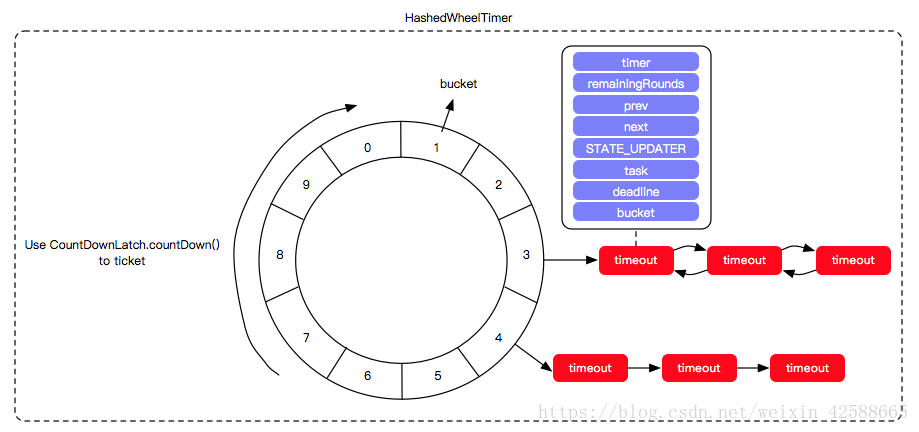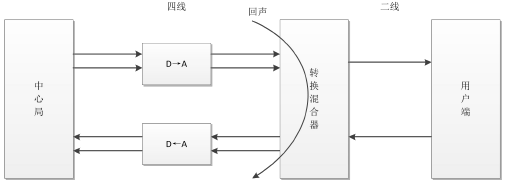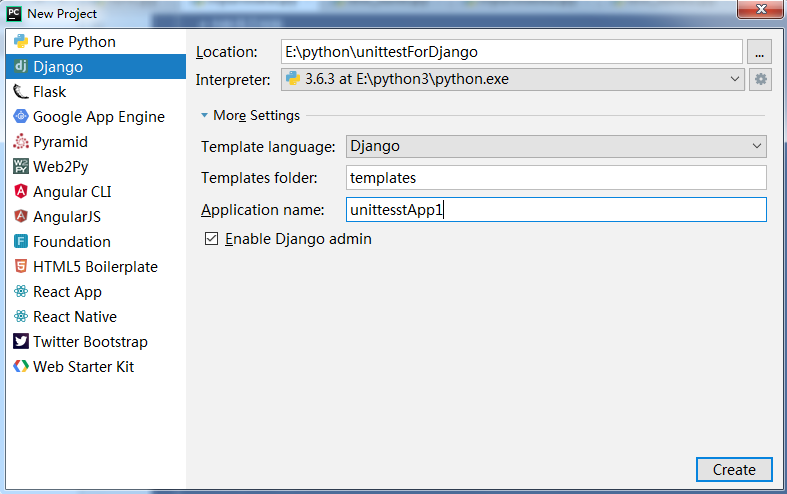2. SOFAJRaft源碼分析—JRaft的定時任務調度器是怎麼做的?
- 2019 年 10 月 19 日
- 筆記
看完這個實現之後,感覺還是要多看源碼,多研究。其實JRaft的定時任務調度器是基於Netty的時間輪來做的,如果沒有看過Netty的源碼,很可能並不知道時間輪演算法,也就很難想到要去使用這麼優秀的定時調度演算法了。
對於介紹RepeatedTimer,我拿Node初始化的時候的electionTimer進行講解
this.electionTimer = new RepeatedTimer("JRaft-ElectionTimer", this.options.getElectionTimeoutMs()) { @Override protected void onTrigger() { handleElectionTimeout(); } @Override protected int adjustTimeout(final int timeoutMs) { //在一定範圍內返回一個隨機的時間戳 //為了避免同時發起選舉而導致失敗 return randomTimeout(timeoutMs); } };構造器
由electionTimer的構造方法可以看出RepeatedTimer需要傳入兩個參數,一個是name,另一個是time
//timer是HashedWheelTimer private final Timer timer; //實例是HashedWheelTimeout private Timeout timeout; public RepeatedTimer(String name, int timeoutMs) { //name代表RepeatedTimer實例的種類,timeoutMs是超時時間 this(name, timeoutMs, new HashedWheelTimer(new NamedThreadFactory(name, true), 1, TimeUnit.MILLISECONDS, 2048)); } public RepeatedTimer(String name, int timeoutMs, Timer timer) { super(); this.name = name; this.timeoutMs = timeoutMs; this.stopped = true; this.timer = Requires.requireNonNull(timer, "timer"); }在構造器中會根據傳進來的值初始化一個name和一個timeoutMs,然後實例化一個timer,RepeatedTimer的run方法是由timer進行回調。在RepeatedTimer中會持有兩個對象,一個是timer,一個是timeout
啟動RepeatedTimer
對於一個RepeatedTimer實例,我們可以通過start方法來啟動它:
public void start() { //加鎖,只能一個執行緒調用這個方法 this.lock.lock(); try { //destroyed默認是false if (this.destroyed) { return; } //stopped在構造器中初始化為ture if (!this.stopped) { return; } //啟動完一次後下次就無法再次往下繼續 this.stopped = false; //running默認為false if (this.running) { return; } this.running = true; schedule(); } finally { this.lock.unlock(); } }在調用start方法進行啟動後會進行一系列的校驗和賦值,從上面的賦值以及加鎖的情況來看,這個是只能被調用一次的。然後會調用到schedule方法中
private void schedule() { if(this.timeout != null) { this.timeout.cancel(); } final TimerTask timerTask = timeout -> { try { RepeatedTimer.this.run(); } catch (final Throwable t) { LOG.error("Run timer task failed, taskName={}.", RepeatedTimer.this.name, t); } }; this.timeout = this.timer.newTimeout(timerTask, adjustTimeout(this.timeoutMs), TimeUnit.MILLISECONDS); }如果timeout不為空,那麼會調用HashedWheelTimeout的cancel方法。然後封裝一個TimerTask實例,當執行TimerTask的run方法的時候會調用RepeatedTimer實例的run方法。然後傳入到timer中,TimerTask的run方法由timer進行調用,並將返回值賦值給timeout。
如果timer調用了TimerTask的run方法,那麼便會回調到RepeatedTimer的run方法中:
RepeatedTimer#run
public void run() { //加鎖 this.lock.lock(); try { //表示RepeatedTimer已經被調用過 this.invoking = true; } finally { this.lock.unlock(); } try { //然後會調用RepeatedTimer實例實現的方法 onTrigger(); } catch (final Throwable t) { LOG.error("Run timer failed.", t); } boolean invokeDestroyed = false; this.lock.lock(); try { this.invoking = false; //如果調用了stop方法,那麼將不會繼續調用schedule方法 if (this.stopped) { this.running = false; invokeDestroyed = this.destroyed; } else { this.timeout = null; schedule(); } } finally { this.lock.unlock(); } if (invokeDestroyed) { onDestroy(); } } protected void onDestroy() { // NO-OP } 這個run方法會由timer進行回調,如果沒有調用stop或destroy方法的話,那麼調用完onTrigger方法後會繼續調用schedule,然後一次次循環調用RepeatedTimer的run方法。
如果調用了destroy方法,在這裡會有一個onDestroy的方法,可以由實現類override複寫執行一個鉤子。
HashedWheelTimer的基本介紹

HashedWheelTimer通過一定的hash規則將不同timeout的定時任務劃分到HashedWheelBucket進行管理,而HashedWheelBucket利用雙向鏈表結構維護了某一時刻需要執行的定時任務列表
Wheel
時間輪,是一個HashedWheelBucket數組,數組數量越多,定時任務管理的時間精度越精確。tick每走一格都會將對應的wheel數組裡面的bucket拿出來進行調度。
Worker
Worker繼承自Runnable,HashedWheelTimer必須通過Worker執行緒操作HashedWheelTimer中的定時任務。Worker是整個HashedWheelTimer的執行流程管理者,控制了定時任務分配、全局deadline時間計算、管理未執行的定時任務、時鐘計算、未執行定時任務回收處理。
HashedWheelTimeout
是HashedWheelTimer的執行單位,維護了其所屬的HashedWheelTimer和HashedWheelBucket的引用、需要執行的任務邏輯、當前輪次以及當前任務的超時時間(不變)等,可以認為是自定義任務的一層Wrapper。
HashedWheelBucket
HashedWheelBucket維護了hash到其內的所有HashedWheelTimeout結構,是一個雙向隊列。
HashedWheelTimer的構造器
在初始化RepeatedTimer實例的時候會實例化一個HashedWheelTimer:
new HashedWheelTimer(new NamedThreadFactory(name, true), 1, TimeUnit.MILLISECONDS, 2048)然後調用HashedWheelTimer的構造器:
private final HashedWheelBucket[] wheel; private final int mask; private final long tickDuration; private final Worker worker = new Worker(); private final Thread workerThread; private final long maxPendingTimeouts; private static final int INSTANCE_COUNT_LIMIT = 256; private static final AtomicInteger instanceCounter = new AtomicInteger(); private static final AtomicBoolean warnedTooManyInstances = new AtomicBoolean(); public HashedWheelTimer(ThreadFactory threadFactory, long tickDuration, TimeUnit unit, int ticksPerWheel) { tickDuration this(threadFactory, tickDuration, unit, ticksPerWheel, -1); } public HashedWheelTimer(ThreadFactory threadFactory, long tickDuration, TimeUnit unit, int ticksPerWheel, long maxPendingTimeouts) { if (threadFactory == null) { throw new NullPointerException("threadFactory"); } //unit = MILLISECONDS if (unit == null) { throw new NullPointerException("unit"); } if (tickDuration <= 0) { throw new IllegalArgumentException("tickDuration must be greater than 0: " + tickDuration); } if (ticksPerWheel <= 0) { throw new IllegalArgumentException("ticksPerWheel must be greater than 0: " + ticksPerWheel); } // Normalize ticksPerWheel to power of two and initialize the wheel. // 創建一個HashedWheelBucket數組 // 創建時間輪基本的數據結構,一個數組。長度為不小於ticksPerWheel的最小2的n次方 wheel = createWheel(ticksPerWheel); // 這是一個標示符,用來快速計算任務應該呆的格子。 // 我們知道,給定一個deadline的定時任務,其應該呆的格子=deadline%wheel.length.但是%操作是個相對耗時的操作,所以使用一種變通的位運算代替: // 因為一圈的長度為2的n次方,mask = 2^n-1後低位將全部是1,然後deadline&mast == deadline%wheel.length // java中的HashMap在進行hash之後,進行index的hash定址定址的演算法也是和這個一樣的 mask = wheel.length - 1; // Convert tickDuration to nanos. //tickDuration傳入是1的話,這裡會轉換成1000000 this.tickDuration = unit.toNanos(tickDuration); // Prevent overflow. // 校驗是否存在溢出。即指針轉動的時間間隔不能太長而導致tickDuration*wheel.length>Long.MAX_VALUE if (this.tickDuration >= Long.MAX_VALUE / wheel.length) { throw new IllegalArgumentException(String.format( "tickDuration: %d (expected: 0 < tickDuration in nanos < %d", tickDuration, Long.MAX_VALUE / wheel.length)); } //將worker包裝成thread workerThread = threadFactory.newThread(worker); //maxPendingTimeouts = -1 this.maxPendingTimeouts = maxPendingTimeouts; //如果HashedWheelTimer實例太多,那麼就會列印一個error日誌 if (instanceCounter.incrementAndGet() > INSTANCE_COUNT_LIMIT && warnedTooManyInstances.compareAndSet(false, true)) { reportTooManyInstances(); } }這個構造器裡面主要做一些初始化的工作。
- 初始化一個wheel數據,我們這裡初始化的數組長度為2048.
- 初始化mask,用來計算槽位的下標,類似於hashmap的槽位的演算法,因為wheel的長度已經是一個2的n次方,所以2^n-1後低位將全部是1,用&可以快速的定位槽位,比%耗時更低
- 初始化tickDuration,這裡會將傳入的tickDuration轉化成納秒,那麼這裡是1000,000
- 校驗整個時間輪走完的時間不能過長
- 包裝worker執行緒
- 因為HashedWheelTimer是一個很消耗資源的一個結構,所以校驗HashedWheelTimer實例不能太多,如果太多會列印error日誌
啟動timer
時間輪演算法中並不需要手動的去調用start方法來啟動,而是在添加節點的時候會啟動時間輪。
我們在RepeatedTimer的schedule方法里會調用newTimeout向時間輪中添加一個任務。
HashedWheelTimer#newTimeout
public Timeout newTimeout(TimerTask task, long delay, TimeUnit unit) { if (task == null) { throw new NullPointerException("task"); } if (unit == null) { throw new NullPointerException("unit"); } long pendingTimeoutsCount = pendingTimeouts.incrementAndGet(); if (maxPendingTimeouts > 0 && pendingTimeoutsCount > maxPendingTimeouts) { pendingTimeouts.decrementAndGet(); throw new RejectedExecutionException("Number of pending timeouts (" + pendingTimeoutsCount + ") is greater than or equal to maximum allowed pending " + "timeouts (" + maxPendingTimeouts + ")"); } // 如果時間輪沒有啟動,則啟動 start(); // Add the timeout to the timeout queue which will be processed on the next tick. // During processing all the queued HashedWheelTimeouts will be added to the correct HashedWheelBucket. long deadline = System.nanoTime() + unit.toNanos(delay) - startTime; // Guard against overflow. //在delay為正數的情況下,deadline是不可能為負數 //如果為負數,那麼說明超過了long的最大值 if (delay > 0 && deadline < 0) { deadline = Long.MAX_VALUE; } // 這裡定時任務不是直接加到對應的格子中,而是先加入到一個隊列里,然後等到下一個tick的時候, // 會從隊列里取出最多100000個任務加入到指定的格子中 HashedWheelTimeout timeout = new HashedWheelTimeout(this, task, deadline); //Worker會去處理timeouts隊列裡面的數據 timeouts.add(timeout); return timeout; }在這個方法中,在校驗之後會調用start方法啟動時間輪,然後設置deadline,這個時間等於時間輪啟動的時間點+延遲的的時間;
然後新建一個HashedWheelTimeout實例,會直接加入到timeouts隊列中去,timeouts對列會在worker的run方法裡面取出來放入到wheel中進行處理。
然後我們來看看start方法:
HashedWheelTimer#start
private static final AtomicIntegerFieldUpdater<HashedWheelTimer> workerStateUpdater = AtomicIntegerFieldUpdater.newUpdater(HashedWheelTimer.class,"workerState"); private volatile int workerState; //不需要你主動調用,當有任務添加進來的的時候他就會跑 public void start() { //workerState一開始的時候是0(WORKER_STATE_INIT),然後才會設置為1(WORKER_STATE_STARTED) switch (workerStateUpdater.get(this)) { case WORKER_STATE_INIT: //使用cas來獲取啟動調度的權力,只有競爭到的執行緒允許來進行實例啟動 if (workerStateUpdater.compareAndSet(this, WORKER_STATE_INIT, WORKER_STATE_STARTED)) { //如果成功設置了workerState,那麼就調用workerThread執行緒 workerThread.start(); } break; case WORKER_STATE_STARTED: break; case WORKER_STATE_SHUTDOWN: throw new IllegalStateException("cannot be started once stopped"); default: throw new Error("Invalid WorkerState"); } // 等待worker執行緒初始化時間輪的啟動時間 // Wait until the startTime is initialized by the worker. while (startTime == 0) { try { //這裡使用countDownLauch來確保調度的執行緒已經被啟動 startTimeInitialized.await(); } catch (InterruptedException ignore) { // Ignore - it will be ready very soon. } } }由這裡我們可以看出,啟動時間輪是不需要手動去調用的,而是在有任務的時候會自動運行,防止在沒有任務的時候空轉浪費資源。
在start方法裡面會使用AtomicIntegerFieldUpdater的方式來更新workerState這個變數,如果沒有啟動過那麼直接在cas成功之後調用start方法啟動workerThread執行緒。
如果workerThread還沒運行,那麼會在while循環中等待,直到workerThread運行為止才會往下運行。
開始時間輪轉
時間輪的運轉是在Worker的run方法中進行的:
Worker#run
private final Set<Timeout> unprocessedTimeouts = new HashSet<>(); private long tick; public void run() { // Initialize the startTime. startTime = System.nanoTime(); if (startTime == 0) { // We use 0 as an indicator for the uninitialized value here, so make sure it's not 0 when initialized. startTime = 1; } //HashedWheelTimer的start方法會繼續往下運行 // Notify the other threads waiting for the initialization at start(). startTimeInitialized.countDown(); do { //返回的是當前的nanoTime- startTime //也就是返回的是 每 tick 一次的時間間隔 final long deadline = waitForNextTick(); if (deadline > 0) { //算出時間輪的槽位 int idx = (int) (tick & mask); //移除cancelledTimeouts中的bucket // 從bucket中移除timeout processCancelledTasks(); HashedWheelBucket bucket = wheel[idx]; // 將newTimeout()方法中加入到待處理定時任務隊列中的任務加入到指定的格子中 transferTimeoutsToBuckets(); bucket.expireTimeouts(deadline); tick++; } // 校驗如果workerState是started狀態,那麼就一直循環 } while (workerStateUpdater.get(HashedWheelTimer.this) == WORKER_STATE_STARTED); // Fill the unprocessedTimeouts so we can return them from stop() method. for (HashedWheelBucket bucket : wheel) { bucket.clearTimeouts(unprocessedTimeouts); } for (;;) { HashedWheelTimeout timeout = timeouts.poll(); if (timeout == null) { break; } //如果有沒有被處理的timeout,那麼加入到unprocessedTimeouts對列中 if (!timeout.isCancelled()) { unprocessedTimeouts.add(timeout); } } //處理被取消的任務 processCancelledTasks(); }- 這個方法首先會設置一個時間輪的開始時間startTime,然後調用startTimeInitialized的countDown讓被阻塞的執行緒往下運行
- 調用waitForNextTick等待到下次tick的到來,並返回當次的tick時間-startTime
- 通過&的方式獲取時間輪的槽位
- 移除掉被取消的task
- 將timeouts中的任務轉移到對應的wheel槽位中,如果槽位中不止一個bucket,那麼串成一個鏈表
- 執行格子中的到期任務
- 遍歷整個wheel,將過期的bucket放入到unprocessedTimeouts隊列中
- 將timeouts中過期的bucket放入到unprocessedTimeouts隊列中
上面所有的過期但未被處理的bucket會在調用stop方法的時候返回unprocessedTimeouts隊列中的數據。所以unprocessedTimeouts中的數據只是做一個記錄,並不會再次被執行。
時間輪的所有處理過程都在do-while循環中被處理,我們下面一個個分析
處理被取消的任務
Worker#processCancelledTasks
private void processCancelledTasks() { for (;;) { HashedWheelTimeout timeout = cancelledTimeouts.poll(); if (timeout == null) { // all processed break; } try { timeout.remove(); } catch (Throwable t) { if (LOG.isWarnEnabled()) { LOG.warn("An exception was thrown while process a cancellation task", t); } } } }這個方法相當的簡單,因為在調用HashedWheelTimer的stop方法的時候會將要取消的HashedWheelTimeout實例放入到cancelledTimeouts隊列中,所以這裡只需要循環把隊列中的數據取出來,然後調用HashedWheelTimeout的remove方法將自己在bucket移除就好了
HashedWheelTimeout#remove
void remove() { HashedWheelBucket bucket = this.bucket; if (bucket != null) { //這裡面涉及到鏈表的引用摘除,十分清晰易懂,想了解的可以去看看 bucket.remove(this); } else { timer.pendingTimeouts.decrementAndGet(); } }轉移數據到時間輪中
Worker#transferTimeoutsToBuckets
private void transferTimeoutsToBuckets() { // transfer only max. 100000 timeouts per tick to prevent a thread to stale the workerThread when it just // adds new timeouts in a loop. // 每次tick只處理10w個任務,以免阻塞worker執行緒 for (int i = 0; i < 100000; i++) { HashedWheelTimeout timeout = timeouts.poll(); if (timeout == null) { // all processed break; } //已經被取消了; if (timeout.state() == HashedWheelTimeout.ST_CANCELLED) { // Was cancelled in the meantime. continue; } //calculated = tick 次數 long calculated = timeout.deadline / tickDuration; // 計算剩餘的輪數, 只有 timer 走夠輪數, 並且到達了 task 所在的 slot, task 才會過期 timeout.remainingRounds = (calculated - tick) / wheel.length; //如果任務在timeouts隊列裡面放久了, 以至於已經過了執行時間, 這個時候就使用當前tick, 也就是放到當前bucket, 此方法調用完後就會被執行 final long ticks = Math.max(calculated, tick); // Ensure we don't schedule for past. //// 算出任務應該插入的 wheel 的 slot, slotIndex = tick 次數 & mask, mask = wheel.length - 1 int stopIndex = (int) (ticks & mask); HashedWheelBucket bucket = wheel[stopIndex]; //將timeout加入到bucket鏈表中 bucket.addTimeout(timeout); } }- 每次調用這個方法會處理10w個任務,以免阻塞worker執行緒
- 在校驗之後會用timeout的deadline除以每次tick運行的時間tickDuration得出需要tick多少次才會運行這個timeout的任務
- 由於timeout的deadline實際上還包含了worker執行緒啟動到timeout加入隊列這段時間,所以在算remainingRounds的時候需要減去當前的tick次數
|_____________________|____________ worker啟動時間 timeout任務加入時間 - 最後根據計算出來的ticks來&算出wheel的槽位,加入到bucket鏈表中
執行到期任務
在worker的run方法的do-while循環中,在根據當前的tick拿到wheel中的bucket後會調用expireTimeouts方法來處理這個bucket的到期任務
HashedWheelBucket#expireTimeouts
// 過期並執行格子中的到期任務,tick到該格子的時候,worker執行緒會調用這個方法, //根據deadline和remainingRounds判斷任務是否過期 public void expireTimeouts(long deadline) { HashedWheelTimeout timeout = head; // process all timeouts //遍歷格子中的所有定時任務 while (timeout != null) { // 先保存next,因為移除後next將被設置為null HashedWheelTimeout next = timeout.next; if (timeout.remainingRounds <= 0) { //從bucket鏈表中移除當前timeout,並返回鏈表中下一個timeout next = remove(timeout); //如果timeout的時間小於當前的時間,那麼就調用expire執行task if (timeout.deadline <= deadline) { timeout.expire(); } else { //不可能發生的情況,就是說round已經為0了,deadline卻>當前槽的deadline // The timeout was placed into a wrong slot. This should never happen. throw new IllegalStateException(String.format("timeout.deadline (%d) > deadline (%d)", timeout.deadline, deadline)); } } else if (timeout.isCancelled()) { next = remove(timeout); } else { //因為當前的槽位已經過了,說明已經走了一圈了,把輪數減一 timeout.remainingRounds--; } //把指針放置到下一個timeout timeout = next; } }expireTimeouts方法會根據當前tick到的槽位,然後獲取槽位中的bucket並找到鏈表中到期的timeout並執行
- 因為每一次的指針都會指向bucket中的下一個timeout,所以timeout為空時說明整個鏈表已經遍歷完畢,所以用while循環做非空校驗
- 因為沒一次循環都會把當前的輪數大於零的做減一處理,所以當輪數小於或等於零的時候就需要把當前的timeout移除bucket鏈表
- 在校驗deadline之後執行expire方法,這裡會真正進行任務調用
HashedWheelTimeout#task
public void expire() { if (!compareAndSetState(ST_INIT, ST_EXPIRED)) { return; } try { task.run(this); } catch (Throwable t) { if (LOG.isWarnEnabled()) { LOG.warn("An exception was thrown by " + TimerTask.class.getSimpleName() + '.', t); } } }這裡這個task就是在schedule方法中構建的timerTask實例,調用timerTask的run方法會調用到外層的RepeatedTimer的run方法,從而調用到RepeatedTimer子類實現的onTrigger方法。
到這裡Jraft的定時調度就講完了,感覺還是很有意思的。


